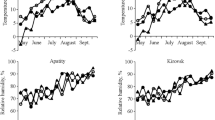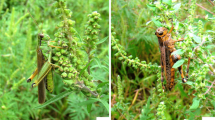Summary
Outbreaks of larvae of Geometrids(Lepidoptera) were since 1961 reported to occur yearly in Slovakia. Nevertheless, it was not earlier than in May 1963 that the larvae of the Feathered Thorn,Colotois (= Himera) pennaria (L. 1661), were found to be the principal defoliator in at least two Slovak localities (Bratislava, Modra). This pest attacked seriously numerous species of foliaceous trees and shrubs, especially the hornbeam, elm, beech, linden, oak, walnut, crab, maple. A quickly dying off of the larvae could be observed outdoors as well as in the rearing under laboratory conditions. The possible meteorological causes of the outbreak are briefly discussed.
Résumé
Dès 1961, on a signalé an par an une gradation plus ou moins accentuée des chenilles des Lé pidoptères Géométridés en Slovaquie. Mais ce n'était qu'en 1963 que nous avons pu constater — à au moins deux localités slovaques (Bratislava, Modra) — une prédominance des chenilles deColotois (= Himera) pennaria (L. 1761) dans les calamités étudiées. Ce ravageur a attaqué sérieusement de nombreuses essences feuillues forestières, particulièrement le charme, orme, hêtre, tilleul, chêne, noyer, pommier, érable. Un dépérissement rapide des chenilles de l'Arpenteuse du Charme s'observait dans la nature ainsi qu'en élevage dans des conditions du laboratoire. Enfin, on trouvera dans l'article une brève discussion des causes météorologiques éventuelles de la gradation.
Резюме
От 1961 г. ежегодные да нные о массовом ра змножении гусениц пяденниц пяденниц в Словак ии появляются. Однако гусеницы г рабовой пяденниц ы,Colotois(= Himera) pennaria (L. 17617), были опре делены только в мае 1963 — по к райней мере в двух месторождениях Словакии (Братисл ава, Модра) — как основный массовы й вредитель. Серье зные повреждения этии видом встреч ались на многочсл енных лиственных пород ах, особенно грабе, ильме, буке, липе, дубу, ор ехе, яблоне, клене. Б ыстрая патогенная гибел ь гусениц наблюда лась в природе и в разведении в ла бораторных услов иях. Возможные метеор ологические прич ины градации кратко дискутиро вны.
Similar content being viewed by others
Literaturverzeichnis
Fankhänel, H., 1961: Zur Massenvermehrung und Überwachung von Frostspannerarten in der Forstwirtschaft der DDR in den Jahren 1958–1960. Beitr. z. Entomol.11, 890–914.
Jahn, E., und A. Sinreich, 1963: Die Massenvermehrung des Hagebuchenspanners,Himera pennaria L., 1962 in Niederösterreich und im Burgenland und die Ursachen des Zusammenbruches der Kalamitä t. Anz. f. Schädlingskunde36, 97–104.
Paclt, J., 1953: Systematisches Verzeichnis der in Mitteleuropa als Forstschädlinge auftretenden Schmetterlinge. Beitr. z. Entomol.3, 1–29.
Rights and permissions
About this article
Cite this article
Paclt, J. Über einen weiteren Fall der Massenvermehrung des Hagebuchenspanners (1963, Südwestslowakei). Anzeiger für Schädlingskunde 37, 106–108 (1964). https://doi.org/10.1007/BF02330066
Issue Date:
DOI: https://doi.org/10.1007/BF02330066




